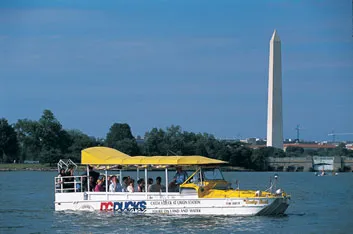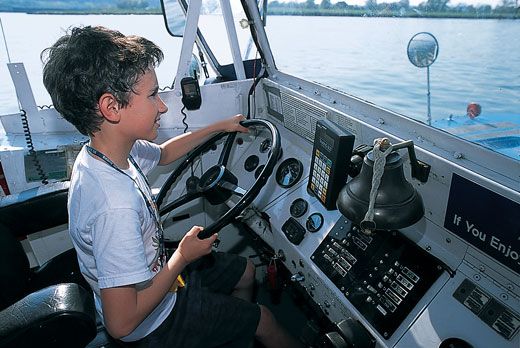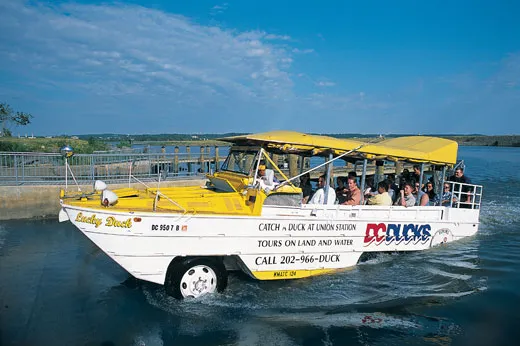Odd DUKW
On land and in the water, World War II’s amphibian workhorse showed the skeptics a thing or two now it shows tourists the sights
Kipling’s description of the civilian attitude toward the soldier in peacetime—“Chuck him out, the brute!”—might as plausibly have applied to many American military vehicles after World War II. With two notable exceptions: the plucky jeep, whose offspring continue to bounce merrily along, and the lesser known DUKW, or “Duck.” These hardy amphibians still earn the kind of accolades once voiced by Winston Churchill as he recalled watching them carry supplies for the liberation of France. “I was fascinated to see the D.U.K.W.s swimming through the harbour, waddling ashore, and then hurrying up the hill to the great dump where the lorries were waiting to take their supplies to the various units. Upon the wonderful efficiency of this system . . . depended the hopes of a speedy and victorious action.”
From Hawaii to Australia and from Seattle to Washington, D.C., DUKWs that once went to war now transport tourists on amphibious sight-seeing treks. While the visitors gawk at the sights, the natives gawk at the DUKWs. Former sight-seeing DUKW captain Jim Nichols once had three war-time DUKW drivers as passengers. “I let them take turns driving in the Potomac,” he says. “There’s a steep pile of rocks along the riverbank. They told me they could take it up those rocks just the way they did in World War II. They told me things about the DUKW I never knew.”
The DUKW saga began in a World War II U.S. government agency where everyone took a pledge of secrecy, so like many an old DUKW cruising today, the tale is a bit patchy. But there are enough memories and declassified records to document how the DUKW was born in a mere 42 days.
On March 20, 1942, Maj. Gen. Jacob L. Devers, chief of the Army’s Armored Force, wrote to Vannevar Bush, director of the Office of Scientific Research and Development, asking whether the OSRD could come up with a way to float light tanks from ship to shore. Bush, who had been vice president of MIT, had made his secretive agency independent of the military, turning to universities and industry for scientists and engineers. His team would help build the atomic bomb and bring to the war such innovations as radar, the bazooka, mine detectors and the proximity fuse. Colliers magazine once referred to him as the “man who may win or lose the war.”
Bush used Devers’ request to advance an idea his people had been working on for months: making a standard Army truck swim so that it could carry men and supplies from ship to shore and across beaches during invasions. Bush handed the project to his chief technical aide, Palmer Cosslett Putnam, who had a reputation for getting things done.
On April 21, Putnam contracted with a subsidiary of General Motors to design, build and test the new vehicle. Three days later, a GM team began putting together a model made of wood, sheet metal and cardboard. Working through a weekend, they finished it on Monday, April 27. They named the project DUKW, based on the GM manufacturing code: D for the model year 1942; U for utility truck, amphibious; K for front-wheel drive; and W for dual rear-driving axles.
Putnam, a yachtsman, asked the naval architectural firm of Sparkman & Stephens to design the hull. Roderick Stephens, known, with his older brother Olin, for winning the 1937 America’s Cup, took on the job. He came up with a welded hull that fit snugly under the chassis of a standard Army truck. It sacrificed not an ounce of the truck’s cargo capacity: it could carry 5,000 pounds or 25 soldiers with gear.
GM engineers redesigned the truck’s rugged transmission so a driver could smoothly shift power from the wheels to a propeller. Even in water, the driver steered normally; when the front wheels turned, so did a rudder at the stern. By June 2, engineers had a pilot model, which they tested on land and, the next day, in a lake near Pontiac, Michigan, with 63 designers and builders on board. In water, the DUKW could go 5 miles per hour; on land its top speed was 50 mph. “She’s better in water than any truck, and she’ll beat any boat on a highway,” Stephens joked.
That summer, he and the engineers worked on getting their DUKWs in a row. But despite a grudging Army order for 2,000 vehicles, there was an “almost total absence of official interest” in the DUKW, according to a project report. “The OSRD was getting nowhere,” says Office of Strategic Services (OSS) veteran Donal McLaughlin.
McLaughlin, now retired and living in a Maryland suburb, had just joined the OSS—the intelligence agency from which the CIA would later emerge—and was assigned to work in secret on a documentary about the DUKW’s capabilities. The film was shown to General Devers and to officers in the Army Corps of Engineers. Devers, Bush later wrote, “was the only man in the Army in an important post who fully saw the [DUKW’s] possibilities.” The film, along with some backstage Pentagon lobbying by the well-connected Putnam and others, managed to keep hope alive. Fearing the amphibians “might sit out the war in some Detroit warehouse,” as Putnam put it, he rededicated himself to championing them through the military bureaucracy.
He invited some 90 officers and civilians to a demonstration off Provincetown, Massachusetts, on Cape Cod, in the first week of December 1942. The plan called for a covey of DUKWs to unload a ship and carry her cargo inland. Then, on the night of December 1, a storm of near-hurricane force hit Provincetown. As it happened, the Coast Guard yawl Rose, conscripted for wartime, was watching for German U-boats. As the Rose made for port, winds of 60 mph slammed her onto a sandbar, where she began to break up. Wind and waves turned back rescue boats, and a desperate Coast Guard officer, who knew about the gathering of DUKWs, called Stephens.
Stephens promptly loaded marine photographer Stanley Rosenfeld and several others onto a DUKW, which then roared down the beach, plunged into the surf and headed for the Rose. Maneuvering the DUKW alongside the foundering craft, Stephens picked up the seven-man crew and returned to shore. Rosenfeld headed for his New York studio, printed the dramatic rescue photos, got on a train to Washington and handed them to a high-ranking Army official. “I suggested he might enjoy showing them to the Secretary of the Navy,” Rosenfeld recalls. “He was most delighted to demonstrate an Army rescue of the Navy [the Coast Guard was then under Navy control] and was sure that President Roosevelt would also enjoy the event, and so he did.”
At the Provincetown demonstrations four days later, in ten-foot waves, the DUKWs unloaded cargo and a gun battery from a Liberty ship in record time, and carried howitzers and men through surf and across sand dunes. Army observers were enthusiastic about the demonstration, but higher brass, still unable to fit the amphibians into any tactical plan, remained unconvinced.
Somehow, 55 of the still-unloved hybrids wound up in Algeria, where Lt. Gen. George S. “Old Blood-and-Guts” Patton, preparing to invade Sicily, knew exactly what to do with them. He asked for as many as he could get, and when American and British troops stormed ashore beginning July 10, 1943,so did some 1,000 DUKWs. The amphibious vehicles bore men and ammunition onto the beaches—and, in some cases, tied up traffic farther inland in the narrow Sicilian streets. While rough seas stymied Navy landing craft, Army DUKWs plunged in and out of the surf, shuttling supplies and reinforcements ashore.
From that operation on, DUKWs participated in nearly every Allied invasion. On D-day, the first of some 2,000 of them began delivering combat and support troops, along with supplies, to Normandy’s beaches, then headed back to offshore ships with the wounded. At Normandy alone, DUKWs carried 18 million tons ashore. And when the American soldiers crossed the Rhine, 370 DUKWs crossed with them.
African-American soldiers, segregated into all-black units during World War II, were typically assigned to supply or construction duty, often behind the lines. But those assigned to DUKWs often found themselves under fire. These men challenged the existing prejudices against blacks in combat positions.
In France and Germany the DUKWs were sometimes used to carry troops across terrain cut by streams and rivers. In his memoir Parachute Infantry, David Kenyon Webster describes riding a DUKW “like a sailboat in a gentle swell” into Berchtesgaden, gateway to Hitler’s alpine lair, a triumphant moment for a vehicle that Gen. Dwight D. Eisenhower later called “one of the most valuable pieces of equipment produced by the United States during the war.”
In the Pacific, Marines used the DUKW as an assault craft, forming amphibian truck companies known, not suprisingly, as the Quack Corps. For landings in heavy surf, Marine drivers learned to gun the engine and ride the waves, landing well up onshore. When Marines landed on Saipan in June 1944, LSTs—Landing Ship, Tank—disgorged the DUKWs.
Arthur W. Wells, a sergeant in the Second Amphibian Truck (DUKW) Company, says many Marines first jeered at the strange-looking hybrids, shouting “Quack! Quack!” as they lumbered by. The jeers turned to cheers when they saw DUKWs carry wounded Marines out to hospital ships.
By the time the war ended in 1945, GM had built 21,147 DUKWs, many of which would end their days rusting away on Pacific battlefields or in forgotten storage depots in Europe. Those that made it back to the United States joined the gargantuan postwar garage sale. Some DUKWs served as rescue vehicles for fire departments in floodprone towns. Hundreds were converted to odd-looking dump trucks or wreckers, and some went to sea. In California in the late 1940s, hunters of basking sharks harpooned their enormous prey from DUKWs.
Melvin Flath, owner of a Milwaukee trucking firm, was the first person to put the amphibians to sight-seeing service, having picked one up at a war-surplus truck auction in 1946. He installed some used bus seats and began charging50 cents for rides around a local lake.
Gradually, the tourist DUKW idea took off. By the 1990s, more than a million passengers a year were taking the tourist plunge in approximately 225 DUKWs around the country. Today, no one knows precisely how many DUKWs there are in the United States, though estimates range from 300 to 1,000, many owned by collectors.
Then came May 1, 1999. A Hot Springs, Arkansas, DUKW named Miss Majestic entered LakeHamilton carrying some 20 passengers. About 250 yards from shore, the craft began filling with water and sank in 30 seconds. Thirteen people, including three children, drowned. Investigators blamed the tragedy on a dislodged rubber seal.
The Coast Guard and the National Transportation Safety Board moved swiftly to recommend tighter inspections and impose new safety requirements. At a hearing on DUKW safety in December 1999, Robert F. McDowell, manager of a tourist DUKW business, in Branson, Missouri, told investigators that he replaces virtually every unseen part of a military DUKW with modern components for sight-seeing. McDowell, who also runs a small military museum, added that building the amphibians from scratch is probably more costeffective. So tourists will likely soon be sitting in vehicles that look like DUKWs and swim like DUKWs—but won’t really be DUKWs. It won’t happen overnight. Like old soldiers, DUKWs never die; they just fade away.


